- ¿Qué es un parque nacional?
-
- Mar de las Calmas (propuesta)
- Aigüestortes i Estany de Sant Maurici
- Cabrera Archipelago
- Cabañeros
- Caldera de Taburiente
- Doñana
- Garajonay
- Atlantic Islands of Galicia
- Monfragüe
- Ordesa y Monte Perdido
- Picos de Europa
- Sierra de Guadarrama
- Sierra de las Nieves
- Sierra Nevada
- Tablas de Daimiel
- Teide
- Timanfaya
- La Red de un vistazo
- ¿Cómo funciona La Red?
- Cartography
- Central Booking
Transectos: Casamata Noroeste Isabel II
Transectos: Casamata Noroeste Isabel II
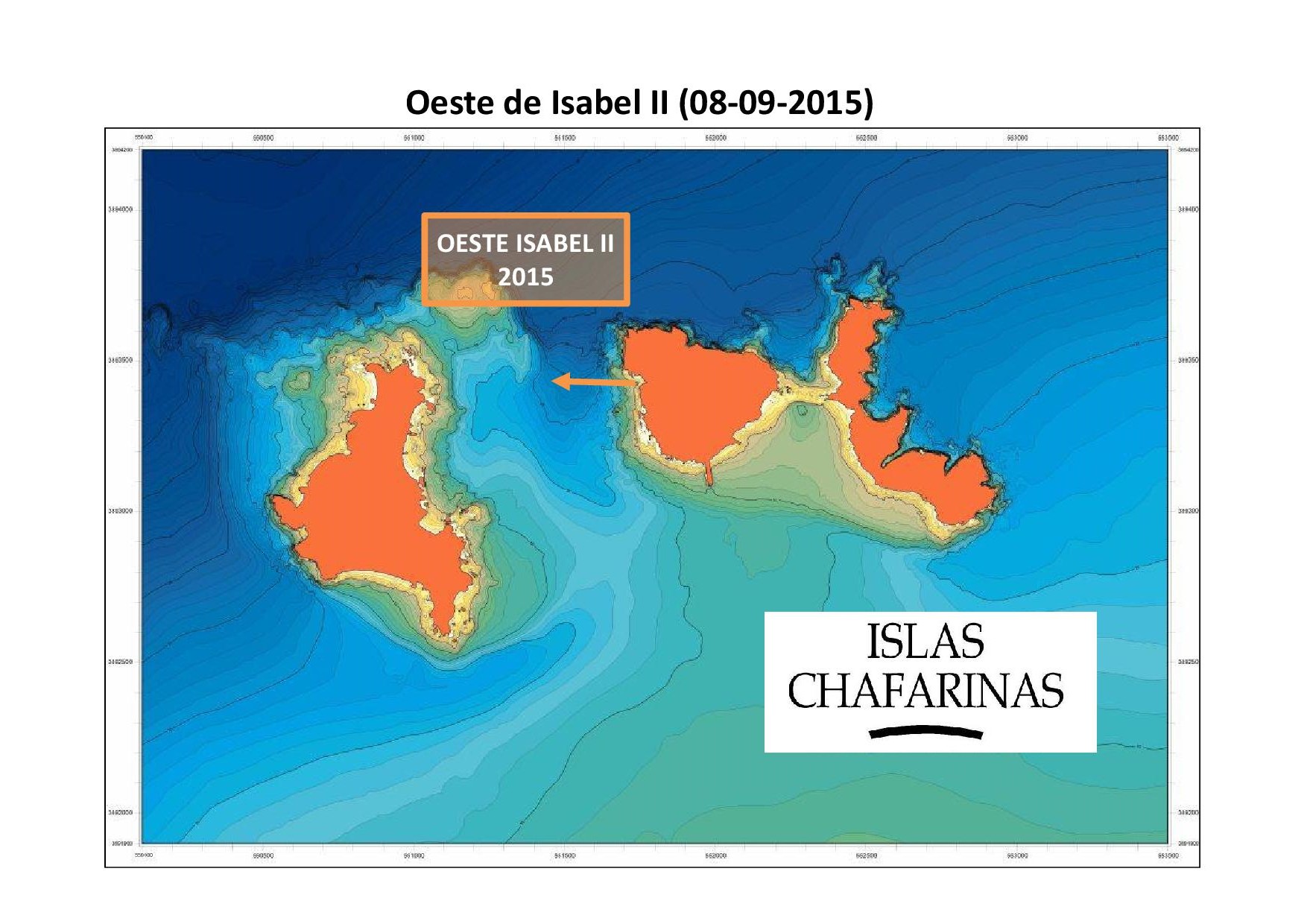 Resumen de las observaciones realizadas en cada metro de profundidad en Casamata Noroeste de Isabel II. Autor: Luis Sánchez Tocino. Universidad de Granada
Resumen de las observaciones realizadas en cada metro de profundidad en Casamata Noroeste de Isabel II. Autor: Luis Sánchez Tocino. Universidad de Granada
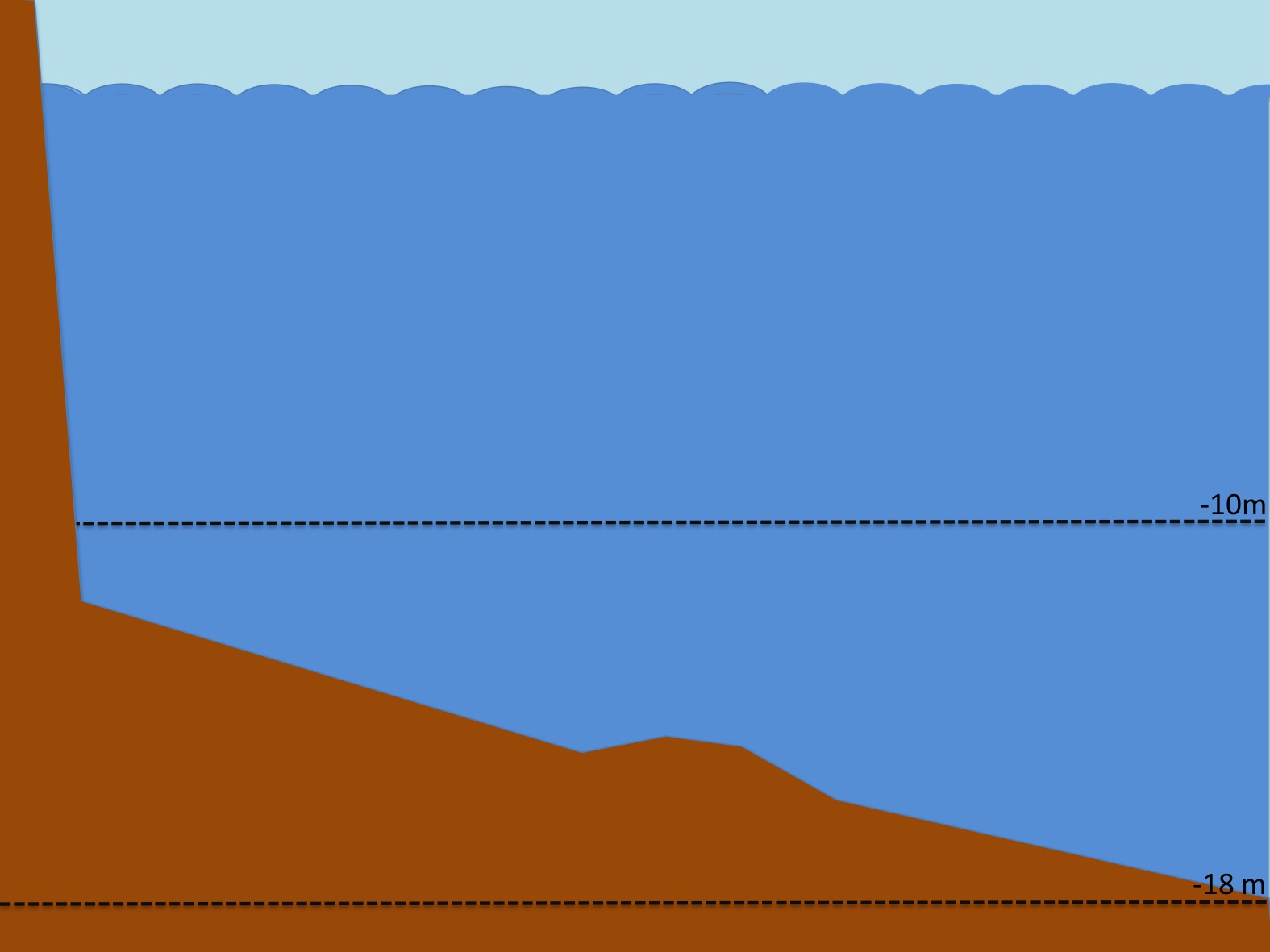 Representación del relieve del terreno en Casamata Noroeste de Isabel II
Representación del relieve del terreno en Casamata Noroeste de Isabel II
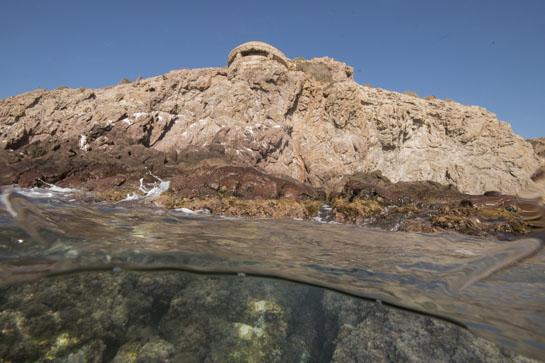 0m. Los moluscos Patella ferruginea y Phorcus turbinatus junto con el cirrípedo Chthamalus stellatus son los organismos más abundantes en el mediolitoral superior.
0m. Los moluscos Patella ferruginea y Phorcus turbinatus junto con el cirrípedo Chthamalus stellatus son los organismos más abundantes en el mediolitoral superior.
 0m. El alga Haliptilon virgatum cubre, prácticamente, todo el fondo a esta profundidad.
0m. El alga Haliptilon virgatum cubre, prácticamente, todo el fondo a esta profundidad.
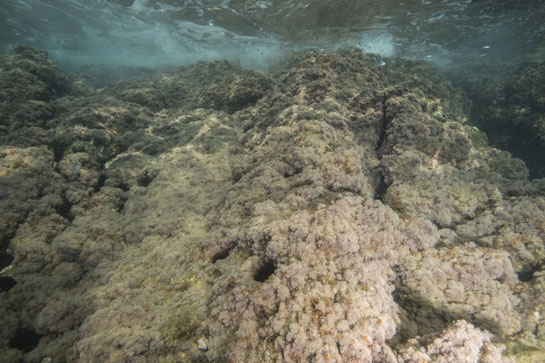 –1m. Sólo algunos erizos rompen la monotonía de esta comunidad de Haliptilon virgatum.
–1m. Sólo algunos erizos rompen la monotonía de esta comunidad de Haliptilon virgatum.
 –2m. El ramoneo de los erizos deja algunas zonas blanquecinas entre las algas.
–2m. El ramoneo de los erizos deja algunas zonas blanquecinas entre las algas.
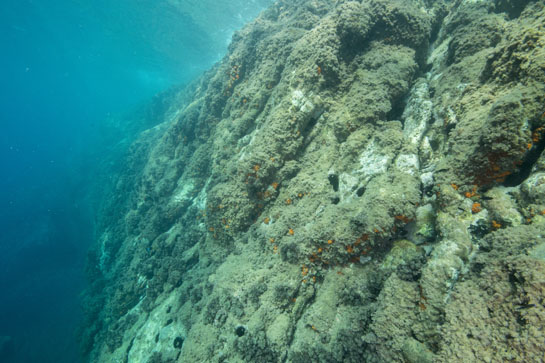 –3m. En los pequeños extraplomos se aprecian algunas colonias de coral anaranjado (Astroides calycularis). En primer plano se pueden ver varias castañuelas (Chromis chromis).
–3m. En los pequeños extraplomos se aprecian algunas colonias de coral anaranjado (Astroides calycularis). En primer plano se pueden ver varias castañuelas (Chromis chromis).
 –4m. En la parte central de la imagen vemos una pequeña comunidad de Algas Calcáreas y Erizos rodeada entre otras por el alga parda Halopteris scoparia.
–4m. En la parte central de la imagen vemos una pequeña comunidad de Algas Calcáreas y Erizos rodeada entre otras por el alga parda Halopteris scoparia.
 –5 m. Varios erizos comunes (Paracentrotus lividus) flanquean una pequeña colonia del madreporario Oculina patagónica.
–5 m. Varios erizos comunes (Paracentrotus lividus) flanquean una pequeña colonia del madreporario Oculina patagónica.
 –6m. La competición por el sustrato entre invertebrados y algas se decanta claramente e a favor de estas últimas.
–6m. La competición por el sustrato entre invertebrados y algas se decanta claramente e a favor de estas últimas.
 –7m. Una pequeña colonia de la gorgonia Eunicella singularis aparece a esta profundidad.
–7m. Una pequeña colonia de la gorgonia Eunicella singularis aparece a esta profundidad.
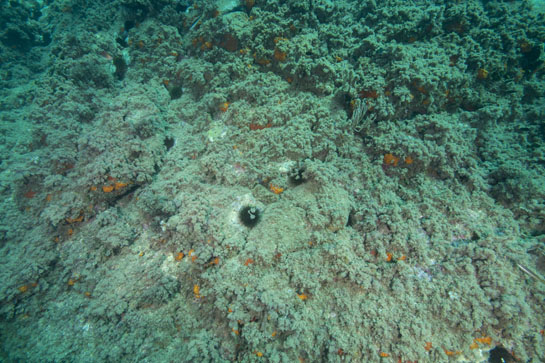 –8m. Erizos comunes (Paracentrotus lividus), coral anaranjado (Astroides calycularis), gorgonias (Eunicella singularis), algunas muertas o parcialmente epifitadas y esponjas (Chondrosia reniformis y, posiblemente, Cambre cambre) son los invertebrados que podemos ver, a simple vista, en esta fotografía.
–8m. Erizos comunes (Paracentrotus lividus), coral anaranjado (Astroides calycularis), gorgonias (Eunicella singularis), algunas muertas o parcialmente epifitadas y esponjas (Chondrosia reniformis y, posiblemente, Cambre cambre) son los invertebrados que podemos ver, a simple vista, en esta fotografía.
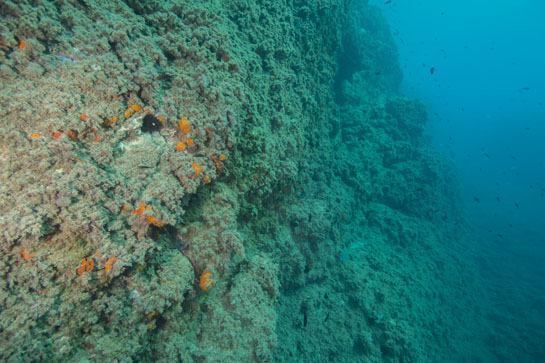 –9m. Exceptuando algunas manchas naranjas de las colonias de Astroides calycularis , la pared sigue descendiendo con un monótono color pardo debido a las algas. En la parte inferior izquierda se puede ver un ejemplar del molusco bivalvo Arca noae, cubierto por una esponja roja.
–9m. Exceptuando algunas manchas naranjas de las colonias de Astroides calycularis , la pared sigue descendiendo con un monótono color pardo debido a las algas. En la parte inferior izquierda se puede ver un ejemplar del molusco bivalvo Arca noae, cubierto por una esponja roja.
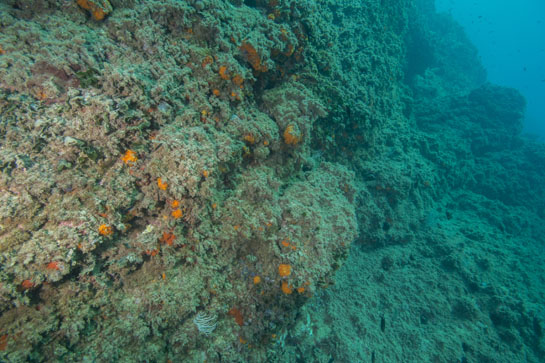 –10m. La inclinación del sustrato y el aumento de la profundidad permite la presencia del alga verde de ambientes umbríos, Flabellia petiolata.
–10m. La inclinación del sustrato y el aumento de la profundidad permite la presencia del alga verde de ambientes umbríos, Flabellia petiolata.
 –11m. A esta profundidad la pared vertical da paso a un fondo menos inclinado, formado por bloques de piedra de diferentes tamaños, cubiertos principalmente por el alga parda Halopteris scoparia.
–11m. A esta profundidad la pared vertical da paso a un fondo menos inclinado, formado por bloques de piedra de diferentes tamaños, cubiertos principalmente por el alga parda Halopteris scoparia.
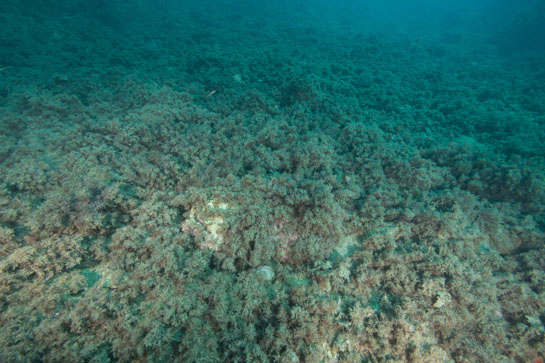 –12m. El bosque de algas pardas se extiende por todo el fondo.
–12m. El bosque de algas pardas se extiende por todo el fondo.
 –13m. Un ejemplar solitario de Anemonia viridis destaca por su color amarillo entre las algas pardas.
–13m. Un ejemplar solitario de Anemonia viridis destaca por su color amarillo entre las algas pardas.
 –14m. El alga parda de color blanquecino Padina pavonica abunda en este fondo blando de arena gruesa con pequeñas piedras.
–14m. El alga parda de color blanquecino Padina pavonica abunda en este fondo blando de arena gruesa con pequeñas piedras.
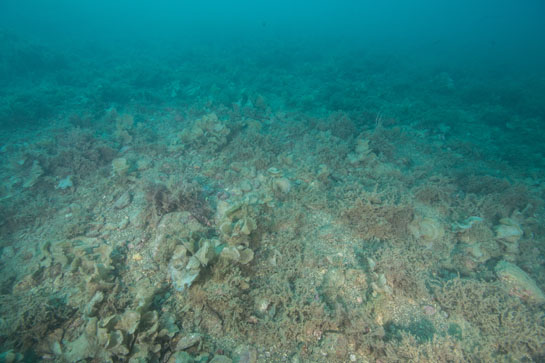 –15m. El alga Padina pavonica, tan abundante en la imagen, se utiliza mucho en cosmética debido a la gran cantidad de calcio que contiene.
–15m. El alga Padina pavonica, tan abundante en la imagen, se utiliza mucho en cosmética debido a la gran cantidad de calcio que contiene.
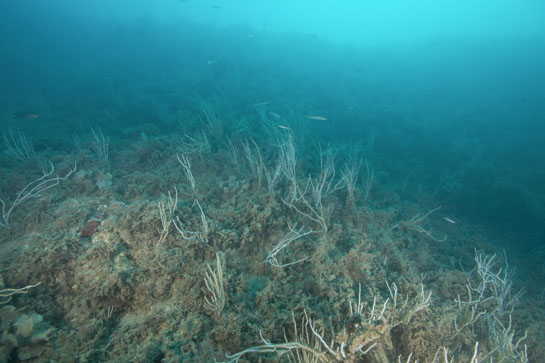 –16m. El transecto corta un promontorio rocoso que aparece por la parte izquierda del mismo y con una gran población de la gorgonia Eunicella singularis.
–16m. El transecto corta un promontorio rocoso que aparece por la parte izquierda del mismo y con una gran población de la gorgonia Eunicella singularis.
 –17m. Entre la comunidad de Eunicella singularis aparece una colonia muerta de Ellisella paraplexauroides.
–17m. Entre la comunidad de Eunicella singularis aparece una colonia muerta de Ellisella paraplexauroides.
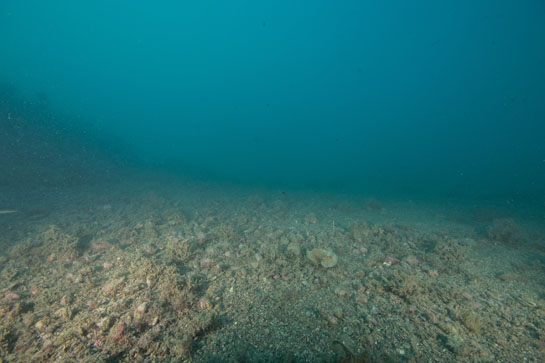 –18m. El transecto continúa hacia el centro del canal, que separa la isla de Isabel II de la del Congreso, con un fondo de arena gruesa y pequeñas piedras.
–18m. El transecto continúa hacia el centro del canal, que separa la isla de Isabel II de la del Congreso, con un fondo de arena gruesa y pequeñas piedras.
This page provides information on cookies we use: We use our own and third-party cookies to keep your session active, personalise your experience, and collect anonymous statistics about how you use this website. You can choose to accept all cookies or select which types you'd like to allow. To learn more about the cookies we use, read our Cookies Policy.
We use two types of cookies on this site. First, there are Functional Cookies, which are essential for the website to work properly. They store session data to make your experience smoother and more convenient. On the other hand, Analytical Cookies collect information about how you use the portal, without personal data, helping us provide a better and more tailored service.
Introduction to the Use of Cookies on the MITECO.gob.es Website
Cookies are small files that are stored on your device when you visit a webpage. They are essential tools that help provide many of the services available on the information society. Among other things, cookies allow a webpage to store and retrieve information about a user's browsing habits or their device. Based on this information, they can be used to recognise the user and enhance the service provided.
Types of Cookies
Depending on the entity that manages the domain from which the cookies are sent and processes the data, there are two types of cookies: first-party cookies and third-party cookies.
There is also a second classification based on how long the cookies remain stored in the user's browser: session cookies and persistent cookies.
Finally, cookies can also be classified into five types based on the purpose for which the data is processed: technical cookies, personalisation cookies, analytics cookies, advertising cookies, and behavioural advertising cookies.
For more information on this, you can refer to the Guide on the use of cookies from the Spanish Data Protection Agency.
Cookies used on the website
The web portal of the Ministry for Ecological Transition and the Demographic Challenge uses Adobe Analytics, an analytics tool that helps website and application owners understand how visitors interact with their content. Adobe Analytics uses a small number of cookies to collect data and generate usage statistics for websites. This information is sent anonymously and is not shared with third parties under any circumstances. You can choose to accept or reject these cookies, as they do not affect the portal’s functionality. However, they help provide valuable information that allows us to offer a better and more tailored service. For more information about Adobe Analytics cookies and privacy, please refer to the following links:
Additionally, pages featuring content from social network X will only set cookies if the user is logged into the X site. For more details on these cookies, please refer to the following link: Privacy on Social Network X
Finally, a technical cookie named MITECO-compliance is stored, which is a first-party, technical, and session-based cookie. It manages user consent for the use of cookies on the website, remembering which users have accepted them and which have not, ensuring that those who have accepted are not shown cookie consent messages at the top of the page. This cookie is essential for the proper functioning of the portal.
Cookies Policy Acceptance / Rejection
The Ministry for Ecological Transition and the Demographic Challenge gives you the option to accept or reject cookies that are not essential for the portal's operation. Upon accessing the portal, a message will be displayed in the centre of the page with information about the cookie policy and the following options:
· Firefox
· Chrome
· Safari